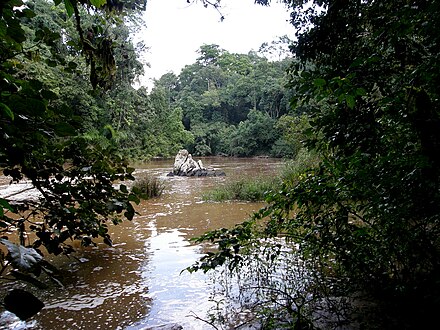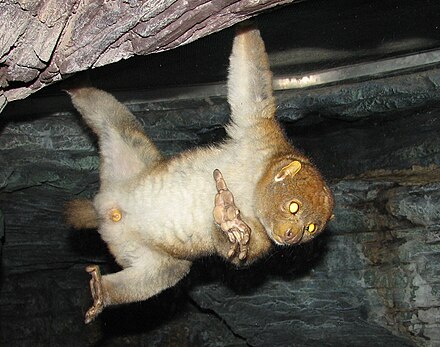Kakamega Rainforest - protected area of Kenya
Kakamega Rainforest is the only tropical rainforest in Kenya. Located in Western Kenya, it is part of a larger area that makes up the last primeval rainforest in the country. It's also home to various monkeys and hundreds of bird species, some of which are threatened.
Understand

Landscape
Geographically Kakamega is an eroded mountain massif, situated about 1500-1600 m (or about one mile) above the sea level and part of the Kavirondo rift, which itself is a part of the East African rift. The highest peaks in the forest are Ikuwya Hill (1779 m), Lirhanda Hill (1734 m) and Buyangu Hill (1633 m), while the lowest point is the Yala river (1466 m). Rivers generally flow from east or northeast to west-southwest.
History
When described in the early 19th century, the rainforest covered 2400 km<sup>2</sup> and was contiguous with the Nandi rainforest — today it has declined into about 10% of that. The Kakamega forest reserve was created in 1926, and in 1967 the Yala (nowadays Lirhanda) and Isecheno natural reserves were established. Back then, the region was used for farming and economical activity on a completely different scale than today, even as fees were eventually instated for using the forest. In 1984 large parts of the forests in the region were cut down in order to establish the Nyao-Kaimosi tea-growing zone, and thereby Kakamega was separated from Nandi.
This was a watershed event in the history of Kakamega and since that measures have been taken to restore the rainforest. One year later the shamba system of small-scale farming (functional since 1910) was scrapped, and the national reserves of Buyangu and Kisere were created. Over the last decades nurseries for native trees, plants and shrubs have been set up, in addition to projects to help the indigenous butterflies (one of the forest's main attractions) and to introduct bee farming. Today "human interaction with the environment" is either prohibited or limited, though local peasants are allowed to pick up dead wood and graze cattle in parts of the forest. In 2010 the Kenya Wildlife Service submitted a proposal to UNESCO to include the Kakamega rainforest on the World Heritage list.
Climate
Daytime temperatures generally vary between 20°C and 30°C, and the lowest temperature ever recorded was 11°C. December to February are the driest months, while April, May and August are the wettest. As Kakamega is located almost right at the Equator, temperatures are in practice constant around the year and monthly differences in precipitation are far less pronounced than in other tropical locations.
Fauna


Large mammals such as elephants are rare in Kakamega, but there are a large number of different birds, snakes and butterflies. About 400 species of butterflies can be encountered here including Acraea, Junonia, Tirumala, Limenitidinae euphaedra and Charaxes, plus other insects like the goliathus goliatus, mantidae, and myriapodae. The forest is also good for birdwatching; you can encounter almost as many different bird species including turacos (including the great blue turaco), old world babblers (including the grey-chested kakamega), sunbirds (including the Nectarinia rubescens kakamegae). The forest is also home to some very rare birds like the psittacus erithacus erithacus (a subspecies of the African grey parrot) of which there are only about a dozen individuals left and the threatened Chapin's flycatcher.
There are about 40 snake species in the forest, many of them poisonous, including black and white cobras, Gaboon vipers, black and green mambas. Moreover there are other reptiles like chameleons, geckos and agamas and amphibians including puddle frogs, the Mascarene grass frog and toads.
Mammals in Kakamega include monkeys and other primates, like the de Brazza's monkeys, mantled guerezas, blue monkeys, red-tailed monkeys, olive baboons and pottos. Other mammals living there are giant squirrels, Egyptian mongooses, civets, giant otter shrews and red river hogs.
Flora
Massive trees characterise the flora of Kakamega. About 350 different plants grow here, of which 160 are endemic, including ferns, orchids and the camphor basil which has many medical uses.
In Isecheno you can find the largest and oldest tree in all Kakamega. Named "mama mutere" by the locals, it's a 40 metres high and about 250 years old maesopsis eminii. Bark of this tree species has been used in traditional medicine against stomach ailments, and it is believed to be helpful against prostate cancer as well.
Get in
See also: Kakamega#Get in

There are different directions for getting in, depending where in the Rainforest you're heading to.
National reserve
By matatu and shared transport
- Starting from Kakamega market, take a matatu (minibus) to Webuye and get off at Mwanza. From there, take a pikipiki (motorcycle taxi) or boda-boda (bike taxi) to Isukuti Guest House.You can also ask to be dropped off at the Kambiri track, but in that case you will need to walk for about 2.3 km by foot.
- A regular taxi from Kakamega to Isukuti Guest House will (as of 2014) cost you Ksh 1500.
By car
- From Kakamega, drive towards Webuye along Highway 1. After 15.6 km, turn right to get to the office of the Kenya Wildlife Service.
Natural reserve
By matatu and shared transport
- Take a matutu from Kakamega's market to Shinyalu. From Shinyalu, continue to the Forest Rest House in Isecheno by pikipiki, boda-boda, or by foot (a 6.3-km walk). If you decide to walk, take left at the Isecheno primary school and walk along the road to the Forest Rest House.
- You can also take a taxi from Kakamega to the Forest Rest House, the ride will also cost you Ksh 1500 (as of 2014).
By car
- From Kakamega, drive along Khasakhala Road (towards the airport) for about 11 km to get to Shinyalu. Then, follow the road from the Isecheno primary school to the Forest Rest House.
Fees and permits
The national reserve is open every day of the year between 6AM and 6PM. The entrance fee for foreigners is USD25 for adults and USD15 for children, youth and students with an international student card. The fee is payable in US dollars or Kenyan shillings. The Isecheno natural reserve is also open between 6AM and 6PM and the entrance fee is Ksh 600. Visiting the forest reserve is free, and you can enter anytime of the day.
Get around
In the national reserve, motor vehicles are prohibited save for on the tracks to the Buyangu housing sites. The tracks are in good condition but rather busy. Otherwise, there are several paths around the forest for getting around by foot or bike.
Bring a hat and waterproof clothes. They are they useful when it rains, and morning mist is a frequent occurrence in the valleys, especially in March and April. Insect repellent is also necessary, in particular for nighttime excursions.
See
See also Flora and fauna above.
Attractions
- Isiukhu Fall, 0.3543°, 34.8813°. Waterfall of the Isiukhu river where it enters the Buyango forest.
- Buyangu Hill, 0.3451°, 34.8632°. A viewpoint in the national reserve, 1633 m above sea level.
- Lirhanda Hill, 0.2170°, 34.8949°. At 1734 m, the second highest mountain in Kakamega, and a viewpoint.
- Batcave, 0.218442°, 34.896539°. A former gold mine, nowadays a good place for observing bats.
Do
.jpg/440px-Lirhanda_Hill_(2293431121).jpg) At the Isecheno entrance, guides are available for short walks, long walks, full day walks, and sunrise walks. The sunrise walk being particularly inspiring.
At the Isecheno entrance, guides are available for short walks, long walks, full day walks, and sunrise walks. The sunrise walk being particularly inspiring.
The Kenya Forest Service organises walks and activities starting from the Forest Rest House in Isecheno:
- birdwatching trip, starting at 6:30AM and 4:30PM, 2 hours, Ksh 500
- visit to a village and its market, 2 hours, Ksh 500
- nighttime excursion, 2 hours, Ksh 1200
- viewing of the sunrise or sunset from Lirhanda Hill and a visit to the Batcave, starting at 5AM and 5PM, 3 hours, Ksh 1200
- Trip to Isiukhu Fall and Buyangu Hill with motorised transport, 3-5 hours, Ksh 2000
- Trip to Yala river, 5-7 hours, Ksh 2000
- Excursion to a traditional mchezo wa ng'ombe bullfight (where two bulls fight each other) in Shibuye or Khayega. Unlike Spanish bullfighting, the point is not to harm or kill the animals. They take place about once a month. Price is negotiated with the park officers.
- Cultural evening with the Luya tribe, with dance performances (isukuti), recitations of stories and legends and lessons in traditional medicine. Price is negotiated with the park officers.
Eat and drink
The places listed in Sleep below, except the Rondo Retreat Lodge, double as restaurants. These are in fact the only places in the rainforest you can have a prepared meal.
Picnicking is allowed anywhere as long as you don't damage the environment. Open fires are nevertheless prohibited outside the designated zones in the camping areas of Udo's bandas and Isecheno KEEP bandas.
Sleep
In the guest houses operated by the KWS, there are two rates, one for foreigners quoted in US dollars, and one for Kenyans quoted in Kenyan shillings.
- Isukuti Guest House, 0.352523°, 34.861051°, +254 56 30603, kakamegaforest@kws.go.ke. Three huts for two persons each. USD60
- Udo's bandas, 0.353024°, 34.863940°, +254 56 30603, kakamegaforest@kws.go.ke. Three huts for two persons, one hut for four persons and a camping area. Hut for 2 persons: USD40, hut for 4 persons USD80, campsite USD15
- Forest Rest House, Off Shinyalu-Chepsonoi Road (Isecheno forest), 0.236847°, 34.866014°, +254 726 951764 (mobile phone), kakamegaforesttour@gmail.com. A lodge for eight persons and two huts. Ksh 500/person/night, breakfast: Ksh 350, lunch Ksh 500, supper: Ksh 500
- Isecheno KEEP bandas, Off Shinyalu-Chepsonoi Road (Isecheno forest), 0.236487°, 34.868249°, +254 726 951764 (mobile phone), kakamegaforesttour@gmail.com. Five comfortable huts with space for a maximum of 21 persons and a camping site. Ksh 900/hut/night, breakfast Ksh 350, lunch Ksh 500, supper Ksh 500
- Rondo Retreat Lodge, Shinyalu-Chepsonoi Road (in the forest reserve near Lirhanda Hill), 0.226910°, 34.884594°, +254 733 527702 (mobile phone), info@trinityfellowship.or.ke. 18 double rooms in a retreat centre of the Christian Trinity Fellowship.
Stay safe
The emergency number is 112.
The national reserve, made up of the Buyangu and Kisere forests is managed by the Kenya Wildlife Servicem and the rest of the Kakamega Rainforest by the Kenya Forest Service.
- Kenya Wildlife Service, +254 20 2418419, +254 20 2654658.
- Kenya Forest Service, +254 726 951764, +254 771 806284 (mobile phone).
- Kakamega police, +254 60 322032.
Open fires are prohibited everywhere save for at the designated areas in the camping grounds. You may encounter poisonous snakes in the forest, especially if you venture off the official trails.
In the national reserve, "human interaction with the environment" is strictly prohibited and can carry a fine of Ksh 5000 or even imprisonment. In the two other areas, local peasants are allowed to pick up dead wood and graze cattle.
Go next
- Nairobi
- Kakamega
- Ilesi Crying Stone, 0.240606°, 34.755613°. A 40-m high rock and one of several "crying stones" in the region. They got their name from the fact that they are always wet at the base, even during dry periods.
- Kaimosi Tea Estate, Route C39A/Stendi Kisa-Yala Road, Kaimosi, 0.1532°, 34.9348°, +254 56 52403. A tea plantation that can be visited by appointment.
Kakamega Forest
Date Time:Please wait...Timezone:Africa/NairobiCoordinates:0.29, 34.86
Kakamega
Primary administrative division
